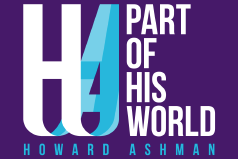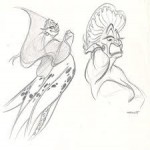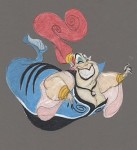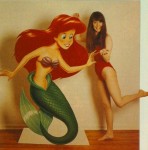John Musker Question Countdown - Number 10
John Musker here, he of the tall, spindly frame and hatchet face, and happy to shed some light on the man who particularly helped Ron Clements and me bring a mermaid to life, and a genie to strut his stuff: the uber-talented, brilliant, and sorely missed Howard Ashman.
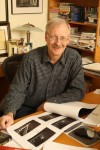
Hopefully my answers to the questions you devoted fans of Howard have thoughtfully posed will shed some light on his invaluable part in shaping some of the films Ron and I directed and co-wrote with a number of talented writers. Our films, The Little Mermaid, Aladdin and even Hercules, to a certain extent which I’ll elaborate on later, had the good fortune to have Howard not only writing songs for them, but helping to shape story lines, characters, and even visuals in some cases.
I will take a “Mulligan” disclaimer that the twenty years that have passed since we worked with Howard may have fuzzed my recollections a bit, but my memory is generally pretty good. We have talked about these films on many DVD bonus tracks, and elsewhere but I must confess I almost never listen to them afterwards, so if I cover ground already well-tilled, I apologize in advance.
It was Sarah’s idea to do a “countdown” of replies, which seems a fun way to deliver this medication -- in capsules timed to release for maximum therapeutic value. These are to be read with appropriate recovery periods in between. There’s more than one question coming from the same source on occasion because he or she came up with several good inquiries. With that said, let’s dive in. Drum roll please!
Question Number 10: How much interaction did Howard have with the animators? Did he ever offer any beneficial input to the design or movement of the characters?
On Aladdin, Howard was too ill to be in California and so did not see any animation on it, as I recall. But Little Mermaid was a much different story. When we were developing Little Mermaid in California, we were storyboarding from a script that Ron and I wrote. We were exploring the way the characters and settings might look. During this period, Howard, as co-Producer of the film with me, would spend three weeks of every month out in California. He was writing songs with Alan out here, working on arrangements with Robby Merkin, and had storyboards pitched to him (and Ron and me.) He participated in auditions of the voice actors (both here and in New York) and he reviewed early design concepts with us on both the characters and the settings. He also saw the first experimental animation done on several of the characters (as did we), and would weigh in on it.
Let me back up a bit and explain how we were paired up with Howard in the first place.
Ron Clements had first suggested to management that Hans Christian Andersen’s story The Little Mermaid could be the basis for a Disney animated feature. He wrote a two- page outline that intrigued Michael Eisner and Jeffrey Katzenberg enough to put the idea into development, where visuals began to be explored.
The esteemed actor/writer/director Michael Cristopher ( Witches of Eastwick, Gia) was selected by management to write a script. He may have had a hard time reconciling his dark vision with a Disney fairy tale, but despite having one meeting with him, he never wrote anything on it as far as I know. Ron and I finally met with Peter Schneider, the skinny, volatile VP who ran the animation department under Jeffrey and Roy Disney (ironically Peter had been a company manager on Little Shop in NYC) and pitched ourselves to write it. (Ron had invited me to join him after we had developed a good working relationship on Great Mouse Detective.) Since we were cheap and in-house, Peter let us take a shot.
Meanwhile, Howard was being wooed by Jeffrey Katzenberg, Michael Eisner’s lieutenant at Disney, who ran the Studio. Jeffrey was relentless in his pursuit of creative people he thought could bring life to Disney’s slate of films. Jeffrey had been sold on Howard in part by his friend and colleague David Geffen, who had been a producer of Little Shop off Broadway and was producing a film version of the show. Jeffrey showed Howard a list of projects in development at the Studio, including animated projects. Howard saw Little Mermaid, and being a fan of Disney animation and Anderson , said he’d love to work on it. Howard later mentioned to us he had written “Andersongs”, a collection of songs built around Hans Christian Andersen’s fairytales. To this day I have never heard those songs. I hope they exist somewhere…(Do they, Sarah?)*
After getting Peter’s OK to try a script, we began by writing a ten-page treatment. We were surprised when Peter told us of Howard’s interest in Mermaid and that Howard had some exciting ideas for the project.
“He wants to make your British stuffed shirt, court composer crab Clarence a Rastafarian!! I don’t know, go talk to him, it’s wild!” Peter said. Ron and I had never met Howard but had seen and loved the LA production of Little Shop of Horrors at the Geffen Playhouse in Westwood where Howard had trans-“plant”ed it from NYC. We loved Howard’s humor, the visual qualities, and the way the story was propelled in the songs. We were intrigued and excited to meet him, although a little uncertain about whether Howard knew anything about animation.
We had our first meeting with Howard at the Helmsley Palace Hotel in Manhattan in the summer of 1986. Howard was working on his musical Smile. We had sent him our ten- page treatment and now we would discuss with Howard not only the story itself and the characters, but most critically how songs could be integrated to help tell the story.
I don’t know why, but I had a mental picture of Howard before I met him: dark hair, mustache and beard, glasses, a little heavy. I have no idea where this picture came from, except that the only Howard I knew in life was dark-haired. Maybe the name “Ashman” headed me in the ‘dark’ direction in some goofy, literal way (ashes are dark, right?)
As we opened our Helmsley Palace hotel room door to a crisp knock, I first laid eyes on Howard. Just as I predicted! He had blondish, tousled hair, was thin, wore no glasses, was clean-shaven, and younger than I pictured, too. ( OK, so I missed….on everything…) He asked us if we minded him smoking and we said no problem. He lit the first of several cigarettes, which he smoked with a sharp intensity.
We had the meeting in that venue in part because Howard had never seen the inside of the Helmsley Palace and wanted to see its purported opulence first hand. Knowing him now, perhaps he was curious to see how Leona Helmsley, the Queen of Mean, would decorate. “Frankly,” Howard sniffed, as he sized up our room between puffs on his cigarette, “I’m disappointed.”
There it was: our first introduction to a man who had strong opinions on nearly everything.
I recount this first meeting not only to share the memory of our intro to Howard, but because we discussed Ursula, among other things. And to return to the question I’m finally getting to answer (tell the truth, you had given up on me…) one of the characters whose look and animation was most influenced by Howard was indeed Ursula.
At that time, Howard was big into the campiness of the TV series Dynasty, then in its heyday. He saw the struggle between Ursula and Triton as having the soap-operatic qualities of Dynasty and mentioned how Ursula was really Joan Collins, the show’s vampy villainess Alexis. I was amused by this. Thus, when Ron and I subsequently wrote the script, I pictured full metal Joan Collins as I wrote the dialogue.
Before I had even gotten onto Mermaid, Ron had explored visuals with an artist named Bruce Morris, ironically, my talented roommate from my first year in the CalArts’ character animation program. Bruce had the idea that the witch could be a scorpion fish, or lionfish, and drew her beautiful but deadly, possessing the multiple spiky poisonous appendages those fish have.
As I came on board and we wrote her as an undersea Joan Collins, the drawings began to move that way, too.
Ruben Aquino, an animator who was exploring the looks for a variety of characters for us, fused Joan with a manta ray to interesting effect. She was a diva.
Other artists like Dan Haskett played with different takes in that vein. He drew her as an aquatic Patti LaBelle, influenced by the fish-like fins of hair that gave Patti such a striking and theatrical silhouette to her head.
Rob Minkoff, subsequent director of The Lion King with Roger Allers, was at that time an animator. He had done wonderful animation of the character Basil in The Great Mouse Detective. We assigned Rob to animate the witch, not only because of his exceptional drawing and animating skills, but his strong sense of theatricality as well. Rob had performed on stage and was a good singer. Howard “clicked” with Rob’s charm and extroverted energy. (Ron and I were so low key, people had to guess when we were truly enthusiastic. With Rob, you didn’t have to guess.) Rob explored his own designs of Ursula and walked in one day with a drawing that started her swimming in an entirely new direction.
Rob drew her as an overweight, mascaraed and bejeweled vamp, an I Dream of Jeannie ponytail bouncing behind her portly head. She was vampy, she was campy, and she (and Rob) drew on Divine, the cross-dressing male star of several John Waters’ films which Rob had seen and howled at. This, of course, circled back to Howard because John was a Baltimore native, as was Howard, who shared a lot of John’s sensibilities. Howard loved Rob’s drawing. “She looks like a Miami Beach matron!” he cackled. I seem to remember him laughing, saying he pictured her “playing Mah Jongg by the pool!”
Matt O’Callaghan, also a talented story artist and animator (and now director) took the Divine approach and brought the idea of her lower octopus-like half. Further drawings by Kevin Lima (another great draftsman who became a director… of Enchanted and Tarzan…I sense a pattern here…) made her even more Divine-like with a pink Mohawk.
Glen Keane, the great animator, also pushed her in this mode until we, along with Howard, ran the drawings of Ursula past our boss Jeffrey Katzenberg. He was clearly unnerved by it: “Guys, you’ve gone 18 per cent too far!” I swear that was the actual percentage he cited, but we -- and Howard -- thought Jeffrey might have a point. Although we were disappointed, we had animator Chris Buck, recently back at Disney after work for other studios, further revise the design, looking particularly for a replacement for her “Divine” Mohawk. Chris came up with the simpler ice cream cone coiffure she now sports.
There are two more Howard addenda to this story. We were preparing to shoot some live action reference footage for Rob to use in animating the witch, much as animators had on all the classic Disney features. Eleanor Audley, for example, the voice of Cinderella’s stepmother, had been shot as a guide and inspiration for animator Frank Thomas. Because of the “Divine” influence that we still wanted to keep (despite toning her look down a bit) at Rob’s suggestion we hired a young male actor, Max Kirby, who had some experience in this regard. We had him dress in drag and we shot reference for our first experimental animation of Ursula: the scene where Ariel pays her a visit. We were not the first to shoot men as women in reference footage. For Snow White’s live action reference, the performer who played the hag the beautiful Queen turns into was actually a man. As I recall, Howard himself was a bit thrown by us shooting a guy in drag as reference for a Disney movie. But he rolled with it as we shot Max synching to Pat Carroll’s tracks as Ursula seats herself at her vanity and primps.
We ultimately didn’t shoot any more with Max. But we did go on to shoot reference for most of the scenes of Ariel throughout the movie, working with comedienne Sherri Stoner, and most scenes of Eric with actor Josh Finkel. Our first shoot with Sherri was the only shoot of hers that Howard attended.
It was the scene where Ariel goes to visit Ursula in her lair. We shot that first one on 35mm film, had a medium-sized crew, had make up and sound people -- it was quite the production! We subsequently pared way down, shot them on videotape on more of a shoestring.
I still remember Howard coaching Sherri on that first day, in the scene where the witch magically draws Ariel’s voice from her. Howard acted out for Sherri a way of physicalizing the loss of her voice. He showed her how her body would react as the witch’s disembodied magical hands pulled the voice from her throat. He acted out the torso drawn forward as the hands tugged, followed by the head, and then a sharper movement as the voice is pulled out of her. It was dance-like and very visual, clear and dramatic. And I still see what Howard showed Sherri when I view the actual drawn scene in the final film, animated by Leon Joosen.
There were a few other notes from Howard as we got into animation. He was concerned when he saw the first scenes of Ariel that she wasn’t pretty enough. Those scenes were animated by the great Mark Henn, who draws, at times, somewhat loosely. Being new to the medium, Howard initially had a difficult time filling in the blanks in Mark’s rough animation. The first scene Mark animated of Ariel (“He loves me…he loves me not…”) went through a fair amount of nervous scrutiny from Howard. It wasn’t until Philo Barnhart produced clean drawings over Mark’s where he pushed and refined her prettiness that Howard was relieved.
I remember a few of Howard’s comments about settings, interesting coming from someone with such a strong theatrical background. The first drawings we showed him of Ariel’s room at the palace worried him because he thought they appeared too masculine. He said her room should be more “Laura Ashley.” I knew Laura Ashley because my wife liked her designs at the time as well, so I understood the softer, cozier, more feminine feel that he was missing and we tried to soften the room with less big chunks of wood and more fabric and delicate shapes.
Howard was occasionally bothered by some of the staging choices we made in the film. Ed Gombert is the fantastic story artist who, among other things, really brought Sebastian to life in the storyboards (and created the final design that Duncan Marjoribanks refined in his animation.) Among the many key sequences Ed visualized were Ariel’s no show at the concert, Ariel’s subsequent argument with her father, the entire song Under the Sea, Ariel in the bedroom with her sisters, Sebastian spilling the beans to the King, and Ariel as a human getting ready for bed (and diving under her Howard Ashman /Laura Ashley quilt!) Although Howard loved most of what Ed did, he had problems with the clamshell concert set that Ariel’s sisters appeared in onstage in that early scene. Ed came up with the idea of the revolving clamshell set, and we loved Ed’s build up to the last shell opening and the dramatic reveal of the missing Ariel. Howard fretted that it wasn’t lofty and royal enough. He thought it too Busby Berkley. He envisioned something like a renaissance masque, a more genteel, courtly, elegant minuet. He rolled his eyes as he tried to get his point across to us.
“It seems weird to me that the entire undersea court is at a concert staged specially for the King…and his daughters are doing 42nd Street! We, on the other hand, liked the staging and didn’t feel it cheapened the royal aspect and I guess we didn’t find 42nd Street as tawdry as Howard, so we stuck with Ed’s approach. I don’t recall talking to Howard after the film was done to see if he had changed his mind at all on this (I don’t expect that he did.)
By the time we got into real animation production, Howard was spending most of his time in New York. He may have been frustrated that he couldn’t be closer to the process, but it was his choice, prompted a bit because dealing with Jeffrey’s constant notes frustrated him, but more importantly because he had to look after his own health. Howard, unbeknownst to us at the time, had been diagnosed HIV positive and was concerned that travel could increase his risk of infection. And he missed his partner Bill in New York and New York in general, I think. Thus, Howard was less involved with most of the actual animation of the film.
Whew! Are you still with me? Did I answer the question? What was the question? Howard would certainly have edited this more stringently. He was proud of the economy of Little Shop’s book. I apologize, Howard. I’d say it won’t happen again, but no promises. The shpilkes takes over!
From SA: *Never heard of Andersongs. The closest I can think of is The Snow Queen, the musical Howard wrote for his graduate thesis.
